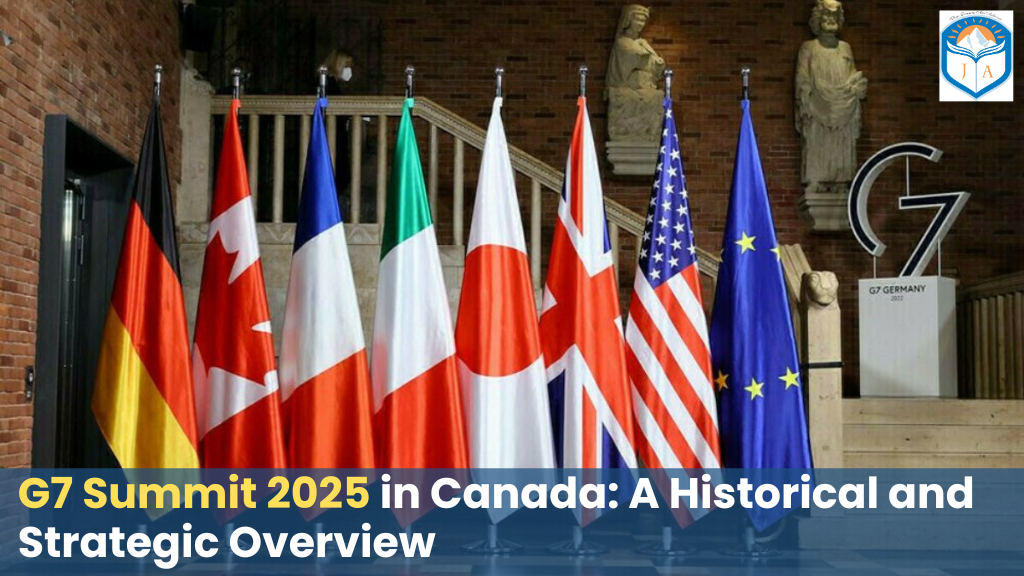G7 Summit 2025 in Canada: A Historical and Strategic Overview
Why in the News?

The year 2025 marks the 50th anniversary of the first G7 Leaders’ Summit, making this year’s summit particularly significant. Scheduled to be held from June 15 to 17, 2025, in Kananaskis, Alberta, the summit is being hosted by Canada, which has previously hosted six G7 summits: in 1981, 1988, 1995, 2002, 2010, and 2018.
What is the G7?
The Group of Seven (G7) is an informal bloc of seven of the world’s most advanced industrial democracies:
- United States
- Canada
- France
- Germany
- Italy
- Japan
- United Kingdom
Together, these nations represent approximately 40% of global GDP and 10% of the world’s population.
The G7 does not have legal status, a permanent secretariat, or binding policy mandates. Instead, it functions as a high-level policy coordination platform, where leaders discuss global economic, political, and social challenges. All decisions made must be ratified individually by the domestic governments of each member state.
Historical Evolution of the G7
Origins in Crisis (1973)
The roots of the G7 can be traced to 1973, when finance ministers and central bank governors from leading industrial nations convened in Paris amidst:
- The oil crisis
- Rising inflation
- The collapse of the Bretton Woods system
U.S. Treasury Secretary George Shultz proposed enhanced coordination among major economies to manage global macroeconomic challenges.
Bretton Woods System: A Brief Flashback
At the Bretton Woods Conference (1944), countries agreed on a new global monetary order, where:
- Currencies were pegged to the U.S. dollar
- The dollar was convertible to gold at a fixed rate
This system ensured stability in international trade and finance and solidified the U.S. dollar’s global dominance—until its collapse in the early 1970s prompted a new need for cooperation.
Birth of the G7 (1975)
In 1975, the first official G7 summit was held in Rambouillet, France, with the participation of:
- France
- Germany
- UK
- USA
- Italy
- Japan
Canada joined in 1976, making it the G7.
EU Involvement
Since 1977, the European Economic Community (now the European Union) has been a regular participant, though not a formal member.
G8 Era and Russia’s Expulsion
After the Cold War, Russia joined in 1998, forming the G8. However, following Russia’s annexation of Crimea in 2014, it was expelled, reverting the group back to the G7.
Presidency and Functioning
Each year, one of the member countries assumes the presidency of the G7, responsible for:
- Setting the agenda
- Organising the summit
- Inviting guest nations
In 2025, Canada holds the presidency and has already invited Ukraine and Australia as guest participants. Other guest countries have yet to be announced.
From Economic Forum to Global Governance
Initially focused on economic policy, the G7 has gradually expanded to include:
- Foreign policy
- Security issues
- Climate change
- Public health
- Technology and cybersecurity
- Global inequality
Each summit typically concludes with a joint communiqué, which outlines non-binding political commitments and sets the tone for international cooperation.
Significance of the 50th Anniversary Summit
- Marks half a century of multilateral dialogue among the world’s leading economies.
- Provides an opportunity to reflect on past achievements and reimagine the G7’s role in a shifting global order.
- Brings attention to rising challenges such as:
- Geopolitical tensions (e.g., Russia-Ukraine, China-Taiwan)
- Climate crises
- Global economic recovery
- AI regulation and tech governance



